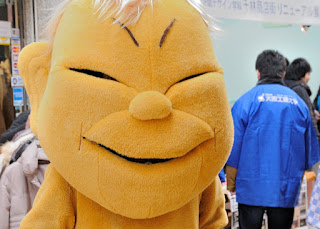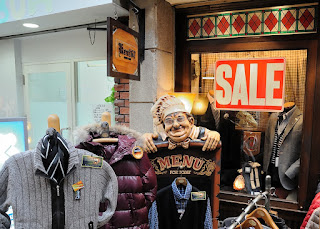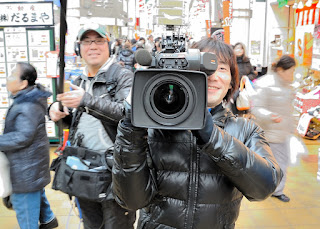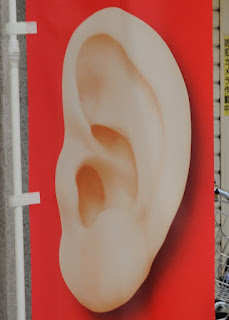Explorations and experiments in visual representations - multimodality, sensory ethnography, reflexivity, autoethnographic vignettes, ethnographic photography and ba...

Sunday, February 24, 2013
"100 Years in Tokyo"
From Japan Today, 2/24/13:
“100 years in Tokyo” is a series of 202 portraits, photographed in Tokyo in 2009-2012. The book contains portraits of men and women for each year of age from 0 to 100.
The book has its origins in photographer Petri Artturi Asikainen’s deep interest in the city. He has lived in Tokyo on several occasions since 2009. For him, the visual abundance of the city makes it exceptionally fascinating. It feels as familiar as any Western metropolis, yet completely different and strange.
The theme of Asikanen’s pictures is the full range of human life. Simultaneously, he hopes to have succeeded in creating a portrait of Tokyo. It is the people that make the city.
Asikainen is a Finnish photographer, who has worked on freelance basis for 20 years. He has contributed to several newspapers, magazines and corporate publications, specializing in portraits and photo editorials.
Source: http://www.japantoday.com/category/arts-culture/view/finnish-photographer-looks-at-life-in-tokyo
More info: http://pa.artturi.com/books/
Friday, February 22, 2013
Turning the Tide: The Fight to Reduce Suicide in Japan
Announcement from SSJ-Forum:
"Saving 10,000 - Winning a War on Suicide in Japan" is a 52-minute documentary directed by TUJ ICAS Adjunct Fellow Dr. Rene Duignan. At this event, Rene will discuss the movie's key findings while showing some excerpts. Unusually for a small documentary, "Saving 10,000" has attracted a lot of media interest with Rene giving over 20 interviews to date. The movie has also sparked interest from politicians with DVD requests from a Minister and Vice-Minister. A special screening/Q&A will be held at the Japanese Parliament in March. Rene has had the privilege of sharing his ideas in a meeting with the head of the Suicide Prevention Unit of the Cabinet Office. After the Japanese media coverage, screening/speaking requests have been coming from all over Japan.
Date: Thursday, March 14, 2013
Time: Door open 7:00 p.m / Talk start 7:30 p.m.
Venue:Temple University, Japan Campus, Azabu Hall 2F
(access: http://www.tuj.ac.jp/maps/tokyo.html)
Speaker: Rene Duignan, ICAS Adjunct Fellow and Economist for the Delegation of the European Union to Japan
Moderator: Robert Dujarric, ICAS Director
Admission: Free (Open to general public)
Language: English
RSVP:icas@tuj.temple.edu
More info: http://www.saving10000.com/
See also Killing Yourself To Make A Living: In Japan Financial Incentives Reward “Suicide”
http://www.japansubculture.com/killing-yourself-to-make-a-living-in-japan-financial-social-incentives-keep-suicide-rates-high/
UPDATE: "Saving 10,000" has been receiving much attention in Japan and internationally in terms of awards and the effort to reduce suicide. The film is now available for free on-line: http://www.saving10000.com/
Thursday, February 21, 2013
2013 Taiwan International Ethnographic Film Festival (TIEFF): Beyond Borders
Announcement from 映像人類学フォーラム (Visual Anthropology Forum):
Calling All Filmmakers! The 2013 Taiwan International Ethnographic Film Festival will be held in Taipei from October 4th to 8th, 2013.
Entry submission deadline: May 10th, 2013
TIEFF is organized by the Taiwan Association of Visual Ethnography (TAVE), a non-profit organization dedicated to greater public awareness of documentary and ethnographic films. TIEFF is more than a venue for screening films and videos; it is also a forum for education, discussion, and exchange.
More information: http://www.tieff.sinica.edu.tw/ch/2013/
Saturday, February 16, 2013
HIV/AIDS Increasing in Osaka
It's been a while since there has been an AIDS related post here at VAOJ - but that is not to say the situation has improved by any means. You might recall that the HIV/AIDS rate continues to increase in Japan. I was surprised to see this advertisement on a Keihan train recently. I only saw one of these posters among numerous other ads on the train and I haven't seen it since. It says that HIV/AIDS in increasing in Osaka with over 2,300 reported cases. Osaka has the second highest rate in Japan. The advertisement encourages testing and treatment.
The advertisement is sponsored by a group called 「おおさかエイズ情報Now」(Osaka AIDS Information Now). Their website (in Japanese only) has general information about AIDS including prevention, testing and counseling.
おおさかエイズ情報Now: http://www.osaka-aids-now.info/
Following some of their links brings you to a site for the Japan HIV Center that has information in English as well.
Japan HIV Center: http://www.npo-jhc.com/index.htm
These seem to be good resources, at least for Japanese and English speakers. Has anybody else seen these advertisements? Or any other advertisements/information on HIV/AIDS in Japan? If so, please leave a comment. This is one issue that should not be ignored or forgot.
Tuesday, February 12, 2013
千林:大阪市100円商店街

Link to 100 yen shopping arcade event (in Japanese): http://www.senbayashi.com/event/event.php
Tuesday, February 5, 2013
"Renowned photographer Leslie Kee arrested in Japan over obscene photos"
From Japan Today, 2/5/13:
Tokyo-based Singaporean photographer Leslie Kee was arrested Monday on suspicion of obscenity after selling books containing pictures of male genitals at a gallery in Tokyo, police said.
The 41-year-old photographer, known for his pictures of Japanese pop stars including Ayumi Hamasaki, Yumi Matsutoya and Kumi Koda, was arrested along with two Japanese publishing firm employees.
The trio sold seven copies of a book “containing many photographs explicitly showing male genitals and others” to two customers at the gallery in the upscale shopping and entertainment district of Minami Aoyama, a Metropolitan Police Department spokesman said.
The book was each priced at 6,000 yen, he added.
The trio could be jailed up to two years and/or fined up to 2.5 million yen if convicted of the obscenity charge.
Under Japanese law pictures of genitals must be obscured, a process usually done through pixellation, which has given rise to its own genre of pornography.
Source: http://www.japantoday.com/category/crime/view/renowned-photographer-leslie-kee-arrested-in-japan-for-alleged-obscenity
Leslie Kee Official Website: http://www.lesliekeesuper.com/
UPDATE: "Fashionistas defend 'obscene' photographer Leslie Kee" (Japan Today, 2/6/13)
Japanese fashionistas on Tuesday came to the defense of Tokyo-based Singaporean photographer Leslie Kee after he was arrested for selling books containing pictures of male genitals.
Kee, who has snapped megastars including Lady Gaga and Super Bowl sensation Beyonce, was arrested Monday on suspicion of obscenity after selling the books at his Tokyo gallery.
The 41-year-old photographer could be jailed for up to two years and/or fined up to 2.5 million yen ($27,000) if convicted.
Pornography is widely available and produced in Japan, but under domestic law genitals must be obscured, a process usually done through pixellation.
“I am stunned by the news of Leslie Kee’s arrest,” Yamamuro Kazz, a leading fashion journalist and magazine editor in Japan, wrote on his website.
He questioned police motivation for the arrest because Kee’s works were available at a gallery event, a forum only open to people familiar with the artistic nature of it.
“The legal interpretation of whether genitals were exposed or not (and whether the work is obscene or not) is totally irrelevant to the intention of an artist,” he said.
“Under their narrow interpretation, works by Terry Richardson and Robert Mapplethorpe are all considered obscene,” he said, referring to prominent U.S. photographers.
Popular model Ai Tominaga tweeted “I am shocked. I am shocked for Japan”, and was joined by others online who expressed similar dismay. Twitter user @onda_natsue said the arrest showed how unsophisticated Japanese culture is.
In 2008, Japan’s top court ruled that nude pictures by Mapplethorpe were not obscene, in a verdict hailed as a victory for artistic freedom in the country, ending a decade-long battle over the censorship laws.
The plaintiff, a Japanese publisher, filed the lawsuit after his copy of a Mapplethorpe book was seized in 1999 when he tried to bring it from the United States for personal use.
Source: http://www.japantoday.com/category/crime/view/japan-fashionistas-defend-obscene-photographer
Tokyo-based Singaporean photographer Leslie Kee was arrested Monday on suspicion of obscenity after selling books containing pictures of male genitals at a gallery in Tokyo, police said.
The 41-year-old photographer, known for his pictures of Japanese pop stars including Ayumi Hamasaki, Yumi Matsutoya and Kumi Koda, was arrested along with two Japanese publishing firm employees.
The trio sold seven copies of a book “containing many photographs explicitly showing male genitals and others” to two customers at the gallery in the upscale shopping and entertainment district of Minami Aoyama, a Metropolitan Police Department spokesman said.
The book was each priced at 6,000 yen, he added.
The trio could be jailed up to two years and/or fined up to 2.5 million yen if convicted of the obscenity charge.
Under Japanese law pictures of genitals must be obscured, a process usually done through pixellation, which has given rise to its own genre of pornography.
Source: http://www.japantoday.com/category/crime/view/renowned-photographer-leslie-kee-arrested-in-japan-for-alleged-obscenity
Leslie Kee Official Website: http://www.lesliekeesuper.com/
UPDATE: "Fashionistas defend 'obscene' photographer Leslie Kee" (Japan Today, 2/6/13)
Japanese fashionistas on Tuesday came to the defense of Tokyo-based Singaporean photographer Leslie Kee after he was arrested for selling books containing pictures of male genitals.
Kee, who has snapped megastars including Lady Gaga and Super Bowl sensation Beyonce, was arrested Monday on suspicion of obscenity after selling the books at his Tokyo gallery.
The 41-year-old photographer could be jailed for up to two years and/or fined up to 2.5 million yen ($27,000) if convicted.
Pornography is widely available and produced in Japan, but under domestic law genitals must be obscured, a process usually done through pixellation.
“I am stunned by the news of Leslie Kee’s arrest,” Yamamuro Kazz, a leading fashion journalist and magazine editor in Japan, wrote on his website.
He questioned police motivation for the arrest because Kee’s works were available at a gallery event, a forum only open to people familiar with the artistic nature of it.
“The legal interpretation of whether genitals were exposed or not (and whether the work is obscene or not) is totally irrelevant to the intention of an artist,” he said.
“Under their narrow interpretation, works by Terry Richardson and Robert Mapplethorpe are all considered obscene,” he said, referring to prominent U.S. photographers.
Popular model Ai Tominaga tweeted “I am shocked. I am shocked for Japan”, and was joined by others online who expressed similar dismay. Twitter user @onda_natsue said the arrest showed how unsophisticated Japanese culture is.
In 2008, Japan’s top court ruled that nude pictures by Mapplethorpe were not obscene, in a verdict hailed as a victory for artistic freedom in the country, ending a decade-long battle over the censorship laws.
The plaintiff, a Japanese publisher, filed the lawsuit after his copy of a Mapplethorpe book was seized in 1999 when he tried to bring it from the United States for personal use.
Source: http://www.japantoday.com/category/crime/view/japan-fashionistas-defend-obscene-photographer
Monday, February 4, 2013
Setsubun @ Naritasan-fudoson Temple in Osaka
Many people are familiar with setsubun in Japan where the beginning of spring is celebrated with its mamemaki (bean throwing ceremonies) and cries of Oni wa soto! Fuku wa uchi! (Devil get out! Good luck in!). There are many local variations of the ceremony within Japan and I was able to see this yesterday at two different locations. The first was the mamemaki celebrated at the Naritasan-fudoson temple in Neyagawa-shi, Osaka. This temple is a branch of the Shingon sect Naritasan Shinshoji temple located in Chiba prefecture. Naritasan is associated with the Buddha figure Fudo and monk Kobo Daishi. Naritasan in Osaka provides the good luck amulets found on all Keihan Railway Company trains and buses. One difference in the Naritasan celebration is that peanuts were thrown to the participants rather than the more common soy beans. The event featured local dignitaries, kabuki actors, geisha and even a sumo wrestler throwing peanuts out to the assembled crowd, many of whom held up paper and plastic bags to get as many peanuts as possible. As it was very crowded I was only able to get into the entrance of the square constructed for the event. I had a height advantage but as soon as the peanuts started raining down the bags people held got in the way. I got one single peanut as it landed on top of my camera. But I was able to get some nice shots capturing brilliant colors on a sunny, warm day.
My second experience was at the shrine near my home. Outside the shrine is a schedule of events and a setsubun festival was listed. However it turned out that there was no bean throwing ceremony and only the Board of Directors of the Shrine were present. I asked them why there was no mamemaki and they laughed and advised me to go to Naritasan (they were amused to hear that I had been there earlier in the day). A shinto priest conducted a brief ritual inside the shrine itself. There were about 10 older men present; it did not seem to be an occasion to take photographs.
At home we performed some of the traditional setsubun celebrations. I received one traditional makizushi roll from one of the men at my local shrine (purchased at an expensive sushi restaurant) and we bought two modern (foreigner-friendly?) rolls at a nearby supermarket - roast beef and grilled beef replaced the usual seven lucky ingredients. The traditional roll tasted much better than the modern ones.
The custom, originating in the Kansai area, is to eat the makizushi without speaking in a specified direction that changes every year. But how is one supposed to know what direction to eat towards? These days we have the benefit of a special iPhone app; a makizushi pointer shows us the way.
See also: ASAHI SHIMBUN PHOTO ESSAY: Purification festival brings out the bean catchers
http://ajw.asahi.com/article/cool_japan/culture/AJ201302030023
Subscribe to:
Comments (Atom)











































